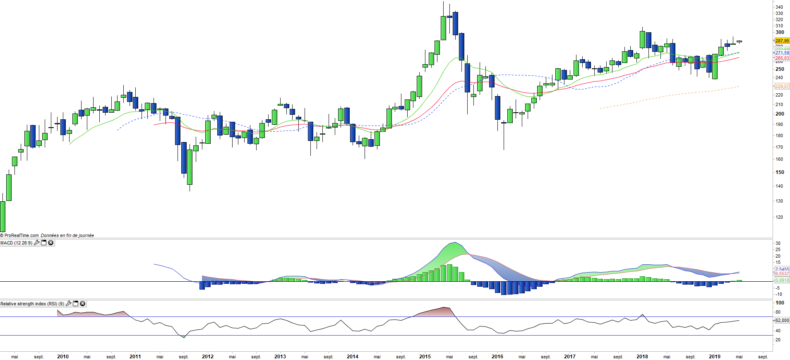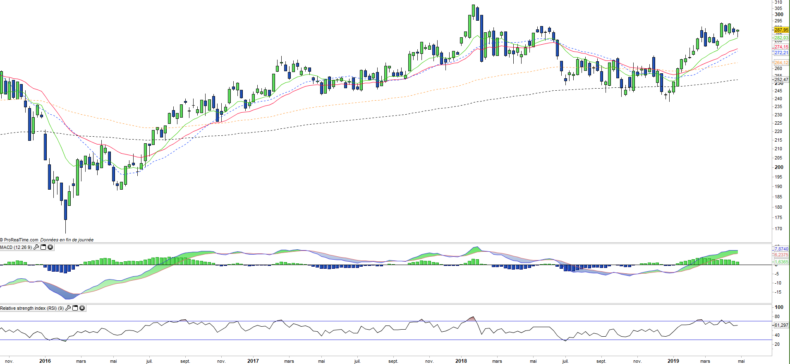Amundi ETF China (CC1) - 06/05/19
Short Term strategy: Positive (90/100)
Long Term strategy: Positive (100/100)
Scores computed by our proprietary algorithms - cf methodology
Characteristics of the ETF
The CC1 ETF (Amundi) created in 03/2009 is listed in Euro on Euronext and replicates the MSCI China-H net dividends reinvested index ("net return"), which is composed of the 50 main Chinese stocks listed in Hong Kong and composed for 2/3 of financial values. These shares are subject to Chinese regulation but denominated in Hong Kong dollar (HKD). Chinese H shares, unlike A shares, are available to non-resident investors in China.
The target for maximum tracking error between changes in the net asset value of the Fund and that of the MSCI China H Index is 2%.
This tracker presents a currency risk linked to the exposure of the MSCI China H Index, resulting from the evolution of the reference currency, the Hong Kong dollar (HKD).
The fee of this ETF is 0.55% for an AUM of 145M €. The replication method is synthetic (via swaps).
Alternative ETFs: CSIA (Lyxor in Euro), FXI (iShares in USD)
Index profile
The equities that make up the MSCI China-H Index come from the universe of the most important stocks in the Chinese market.
The MSCI China-H Index is composed of 50 constituents, so it is relatively diversified. The financial sector (banks and insurance companies), however, accounts for about 66% of the capitalization while the China Construction Bank accounts for 16% of the index.
China is the world's second largest economy behind the US with a GDP of about $ 14200bn in 2018, the world's largest exporter with the world's largest foreign exchange reserves.
The global recession of 2009 interrupted China's continued growth momentum, and the limits of its export-oriented growth model emerged. As a result of the global economic downturn and declining trade, Chinese growth decelerated to below 7% from 2015, its lowest level in 25 years. State-owned enterprise debt accounts for 145% of GDP while private sector debt accounts for more than 200% of GDP. In addition, the quality of bank assets has deteriorated for several years and this trend is probably underestimated because of the importance of the shadow banking.
Many challenges remain linked to the problem of an aging population, the lack of openness of the political system, the competitiveness of an economy dependent on high investment expenditure and the expansion of credit.
The manufacturing and construction sectors contribute nearly half of China's GDP, but the country is increasingly relying on services and domestic consumption.
China has posted a 6.6% growth rate in 2018 and now expects growth between 6- 6.5% n 2019, which means a gradual soft landing linked to the new growth model, more based on quality, corresponding to an upscaling of industry and services, but also focused on reducing the current major imbalances (too high debt, overcapacity in industry and real estate).
China no longer seems to be in the race for growth, but in search of a more balanced and sustainable model based on the upscaling of its industry through technology and the expansion of services and domestic consumption.
China faces geopolitical problems with most of its neighbors (India, Japan ...) and especially in the China Sea, because of its plans for territorial expansion that could lead to military confrontations. Its confrontation with the USA, at the commercial level, could be amplified under the background of the Korean crisis.
The decline in Chinese growth could also be a political issue, if it accelerates, the authorities have an interest in calming the game and save time.
The last tweet of D.Trump on the increase of tariffs from 10% to 25% is likely to bring back volatility on the index, but should not make change its trajectory since the main scenario remains the signature of a deal between the two major powers that need it for internal political issues (including the US election in November 2020).
Monthly data
The monthly chart shows the confirmed return of the Chinese index in long-term uptrend, after the corrective episode of the end of 2018. The MACD has rebounded upwards while remaining very clearly above the zero line which confirms the resumption of the initial trend. The immediate objective of the index is the peak of 2018 at 308 €, before being able to attack the historical 2015 peak of 350 €.
Weekly analysis
The weekly chart shows an uptrend confirmed by the cross between the EMAs12 and 26, as well as the upward reversal of all technical oscillators. The prices come regularly to the EMA12, as is the case now before heading back to new heights. The index arrives in a resistance zone formed by the previous peaks of 2018, and its overtaking is key for a possible acceleration of the trend.
Theme
CC1 is a UCITS ETF, listed in Euro, which seeks to replicate the MSCI China H (50 chinese companies)
Characteristics
| Inception date | 03/03/2009 |
| Expense ratio | 0,55% |
| Issuer | Amundi |
| Benchmark |
MSCI China H
|
| Code/Ticker | CC1 |
| ISIN | LU1681043912 |
| UCITS | Yes |
| EU-SD Status | Out of scope |
| Currency | Euro |
| Exchange | Euronext Paris |
| Assets Under Management | 146 M€ |
| PEA (France) | Yes |
| SRD (France) | Yes |
| Currency Risk | Yes |
| Number of Holdings | 50 |
| Risk | 4/5 |
Country Breakdown
| China | 100% |
Sector Breakdown
| Financials | 66% |
| Energy | 9% |
| Industrials | 7% |
| Materials | 4% |
| Communication Services | 4% |
| Consumer Discretionary | 3% |
| Health Care | 2% |
| Others | 5% |
Top Ten Holdings
| China Construct Bank | 16% |
| ICBC | 11% |
| Ping an Assurance | 10% |
| Bank of China | 7% |
| China Petroleum Chem | 4% |
| China Life Insurance | 4% |
| China Merchants BK H | 3% |
| Petrochina CO H | 3% |
| Agricult BK China-H | 3% |
| China Pacific Insur | 2% |


